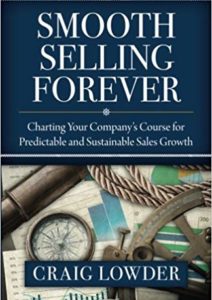What would your company look like if your salespeople were totally in sync and performing well as a team? You’d be experiencing what I call “smooth selling.” Calling on the right target market, articulating the value your company offers in a way that resonates with your customers, finding out more about business plans and services each day, overcoming objections, and measuring the performance of your team and processes to identify what works best, would definitely allow you to close a higher percentage of sales.
This is not a dream scenario. You can achieve these results. But, you need a plan. To create an effective sales strategy that leads to smooth selling you need eight strategic components:
Strategic Component One: Target Markets and Customer Segmentation
A first course of action is to identify those groups of customers that are of the most value to the business. These are the groups that predictably buy more and at better prices (higher margins). They love working with you and you love working with them. Knowing exactly who these ideal customer groups are can help drive selling costs down and enable your company to focus its product and service development efforts where the results will be greater.
Strategic Component Two: Buying Personas and Influences
We know the type of company we want to target but now we need to identify the decision-maker within that company. Start by identifying those individuals that make the purchase decision or are likely to influence a purchase decision by function within the organization. This includes the four key buying-influence roles: (1) economic, (2) technical, (3) user, and (4) coach. A strategy that identifies these individuals allows you to cover your bases by interacting with these four buying influencers to increase the probability of not only making a sale and making the sale at higher margins.
Strategic Component Three: Channel Strategy
How will you take your products or services to market? Should the channel strategy be direct, indirect, or digital? Channel strategy drives selling costs down, drives revenues up, and potentially extends the market reach of a company. A company must determine the sales channels that can reach its target markets and customers most effectively. Some of the factors to weigh:
- Direct versus indirect versus digital sales team
- Hunter versus farmer sales team
- Inside versus outside sales team
- Complex solution versus transactional sales environment
- Salary heavy versus incentive heavy compensation plans
- Customized versus packaged products/services
Evaluate all of these factors from a resource and impact point of view to decide on the best go-to-market channel strategy for your business.
Strategic Component Four: Sales/Customer Buying Process
In simple terms, a sales process is a systematic approach (a repeatable process) involving a series of steps that enables a sales force to close well and boost revenues. There are many reasons why having a documented and implemented process is important. Process increases lead conversion rates, shortens the sales cycle, increases the average dollar sale, improves profit margins, increases the productivity of the sales force, and drives selling costs down. It also allows you to handle growth with ease and consistency. As you grow and bring on new people, it is so much easier to train new salespeople and get them into the field faster to start bringing in new sales. They know the process that works best and can be measured on how well they deliver on the consistent process.
Strategic Component Five: Sales Message and Your Value Proposition
Your sales message is the unique value statement that your sales force delivers to target customers. This message is what sets your company apart from your competition. The message should be simple, presented from your customer’s point of-view, memorable, and differentiating. It should explain what you do, how that benefits the customer, and why you are the best option for their needs. Effectively communicating your company’s uniqueness or value increases conversion rates, shortens the sales cycle, eliminates the competition, increases the average dollar sale, improves profit margins, and increases the productivity of your sales team.
Strategic Component Six: 5 x 5 Revenue Growth Strategies
Like any good investment portfolio, a business needs to diversify its sales growth investments. The five ways that any business can increase its revenues and gross profits are to:
- increase the number of sales leads coming into the business;
- improve the lead-to-close conversion rate;
- increase the number of annual customer transactions;
- increase the average dollar sale per transaction; and,
- improve gross profit margins.
By increasing performance by just 10 percent in each of these five areas, a business will increase revenues by 46 percent and gross profits by a massive 61 percent. It pays to do the math. Where can you boost 10% quickly for some quick wins?
Strategic Component Seven: Performance Metrics
Performance metrics are the quantitative and qualitative measurements a business uses to measure the success or failure of its sales operations. These metrics should include both results- and activity-based measurements. What gets measured gets done, as the old adage goes. Performance metrics ensure that a business is using its sales resources efficiently to drive selling costs down and revenues up.
Strategic Component Eight: Sales Compensation
Proper sales compensation ensures that a business can recruit and retain the most qualified sales talent as well as drive the desired sales behavior expected from members of the sales team. Five methods should be considered when a business decides how it will financially compensate the members of the sales team for their role in generating sales:
- Salary only
- Commission only
- Salary plus commission
- Salary plus bonus
- Spiffs
To do this right requires an assessment by an accomplished sales leader due to the number of variables involved. Done incorrectly, there will be unintended consequences.
To find out how to create and implement a sales strategy that ensures smooth selling at your company, check out my book.
Smooth Selling Forever enables small and mid-size business leaders to generate significant, predictable, and sustainable sales growth. Based in the science of selling, when applied correctly and managed vigilantly, smooth selling produces revenue results in a systematic fashion.
Pipeliner CRM fully empowers sales strategies. Get your free trial of Pipeliner CRM now.





Comments